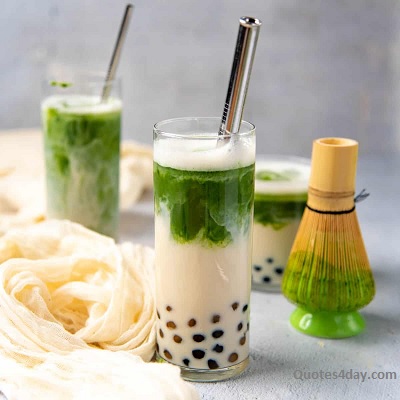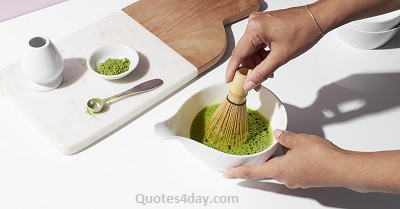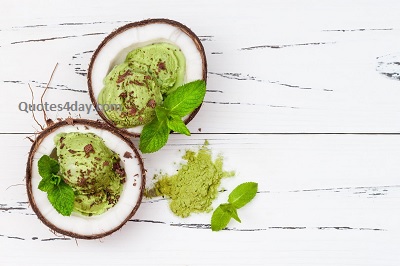Matcha latte (or more correctly matcha latte in Japanese transcription) without exaggeration can be called a loud gastronomic trend since 2018. Repeatedly praised by reputable nutritionists, this drink already has a host of stellar fans and regularly appears on Instagram food photos of popular bloggers. All thanks to the magic ingredient of matcha latte – Japanese powdered matcha tea (aka matcha, but we will call this product as it is called in its homeland).

Matcha Latte Story
Matcha tea is now known as a traditional Japanese drink. However, the pioneers in the manufacture of powdered tea were the Chinese, who invented this method of processing tea leaves as early as the 7th century. And only six centuries later matcha came to Japan. The Japanese improved the manufacturing process and made powdered tea the basis of the traditional Zen Buddhist tea ceremony.
In the West, this drink has become popular relatively recently. True, not in the format of a tea ceremony, but in a form closer to the Western consumer and in English transcription, that is, in the same matcha latte.
Matcha latte is a drink made from matcha (matcha) powder in pink, blue, and other shades, brewed using the sutra method (weak brewing, as opposed to the koicha method – ceremonial strong brewing) and with the addition of milk. It is drunk hot or cold. Milk softens the taste of matcha, removes the characteristic bitterness, and gives the drink a pleasant velvety texture. It is this recipe that has gained such extreme popularity in the United States and Europe. Powdered matcha has 9 kcal per 3-gram serving, while matcha with 3.2% fat cow’s milk has 34.7 kcal, and matcha with almond milk has 70 kcal. This is a low-calorie product.
Health Benefits of Matcha Latte
Matcha tea is grown, harvested, and cultivated in a special way. Only young top foliage goes into production. Two weeks before harvest, the tea bushes are shaded, hiding them from direct sunlight. Due to this, the growth of the tea leaf slows down, and chlorophyll and amino acids accumulate in it. The collected leaf is dried and stems and veins are removed from it and ground into powder. This is how a ready-to-use product is obtained.
Matya is drunk along with tea leaves, enriched with vitamins and microelements, and is also a source of fiber. In reasonable quantities, it can be drunk even during pregnancy. Thus, you get the maximum possible benefit from the drink, no harm – nothing goes to waste. What nutrients are included in the composition and what are they responsible for?
- Antioxidant catechin EGCG
It is due to the significant content of this substance that matcha tea is so valued by fans of a healthy diet. Catechin prevents the development of cancer, and multiple sclerosis, and also improves skin conditions.
- Amino acid L-theanine
This amino acid is a natural neurotransmitter that improves mood, increases the level of mental and physical activity, and improves the ability to concentrate and think clearly.
- Chlorophyll
Removes heavy metals from the body. Promotes an increase in the number of red blood cells in the blood plasma and improves the transport of oxygen to the cells.
- Caffeine
In 1999, the American Journal of Clinical Nutrition published the results of studies confirming the thermogenic properties of matcha tea, its ability to oxidize fats, and promote weight loss due to its significant content of caffeine. Drinking matcha before your workout will burn 25% more calories.
- Plant fibers
Mathieu contains a lot of easily digestible fiber. It is useful in that it helps to cleanse the body of toxins, restores the normal functioning of the gastrointestinal tract and stabilizes blood sugar levels.
How to Make Matcha Latte
Traditional matcha brewing, like everything traditionally Japanese, is not complete without paraphernalia. To do everything according to the rules, you will need:
- Chavan – a ceramic or porcelain bowl for brewing.
- Chasaku is a measuring spoon made of bamboo, with a capacity of 1 gram.
- Strainer – for sifting matti.
- Tyasen is a bamboo whisk for mixing.

The same tools are used to make matcha lattes at home.
Traditional tea matcha latte
Ingredients:
- Purified water (t 80°C): 60-80 ml;
- Matya: 2-3 gr;
- Milk (cow, soy, almond): 150 ml;
- Honey, sugar, maple syrup, or any other sweetener.
Cooking:
- Before cooking, soak the whisk in cold water for 30 minutes or hot water for 5 minutes to soften the bamboo strings and make them more flexible.
- Measure out 2 grams of matcha with a cleaver spoon and sift the tea through a sieve into a chawan bowl.
- Pour the tea powder into 60-80 ml of water at 80°C. Whisk the mixture vigorously with a heavy-weight whisk, moving up and down for about 30 seconds.
You have prepared traditional matcha tea using the essence method. The next steps will turn it into a matcha latte.
- Add a sweetener of your choice to the tea.
- Whip 150 ml of hot milk (preferably full fat) with an electric whisk or in a French press until foam forms.
- Add frothed milk to tea. Our matcha latte is ready!
White chocolate matcha latte
Ingredients:
- Purified water (t 80°C): 60-80 ml;
- Mathieu: 2-3 grams;
- Milk (cow, soy, almond): 150 ml;
- Honey, sugar, maple syrup, or any other sweetener.
- White chocolate – 70 g.
Cooking:
- We repeat all the steps of the previous recipe – we are preparing a classic matcha latte, but thanks to chocolate, it acquires a light vanilla flavor.
- Next, put the mixture of matcha and whipped milk on a small fire, add chopped chocolate, and see through the drink, stirring, until the chocolate is completely dissolved. It is important to prevent the drink from boiling, the temperature should be kept within 80 ° C.
- We remove the drink from the stove and knock it down with an electric whisk or a French press.
You can also get 14 foods to avoid losing weight: What to stop eating and why
Coconut Mint Matcha Latte

Ingredients:
- Coconut milk: 150 ml;
- Cocoa powder: 1/2 tsp;
- Matya: 2-3 gr;
- Peppermint extract: 1/8 tsp;
- Maple syrup: 1 tbsp
Cooking:
- Heat the coconut milk over low heat without boiling it.
- Add cocoa, peppermint, and syrup. Beat the mixture without removing it from the stove.
- Remove the milk from the stove and add the mate powder. Beat the drink with an electric whisk for about 30 seconds.
- Pour the matcha latte into a mug.
FAQs
1. Is a matcha latte healthier than coffee?
Yes, a matcha latte is a healthier alternative to coffee as it provides a slow and steady release of energy without the crash that comes with coffee.
2. Can I use any type of milk for a matcha latte?
Yes, you can use any type of milk you like, such as cow’s milk, almond milk, oat milk, or soy milk.
3. Is it necessary to sift the matcha powder before making the latte?
Yes, it’s recommended to sift the matcha powder before making the latte to remove any lumps and ensure a smooth and creamy texture.
4. Can I add sweeteners to the matcha latte?
Yes, you can add sweeteners such as honey or sugar to matcha latte to taste.
5. How often can I drink a matcha latte?
You can drink a matcha latte daily as part of a balanced and healthy diet, but it’s important not to overconsume it due to its caffeine content.


